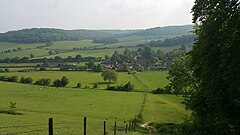| Turville | |
|---|---|
 View from a hill overlooking Turville | |
Location within Buckinghamshire | |
| Population | 340 (2011 Census)[1] |
| OS grid reference | SU765915 |
| Civil parish |
|
| Unitary authority | |
| Ceremonial county | |
| Region | |
| Country | England |
| Sovereign state | United Kingdom |
| Post town | HENLEY-ON-THAMES |
| Postcode district | RG9 |
| Dialling code | 01491 |
| Police | Thames Valley |
| Fire | Buckinghamshire |
| Ambulance | South Central |
| UK Parliament | |
Turville is a village and civil parish in Buckinghamshire, England. It is in the Chiltern Hills, 5 miles (8.0 km) west of High Wycombe, 6 miles (9.7 km) east-southeast of Watlington, 7 miles (11 km) north of Henley-on-Thames and 2 miles (3 km) from the Oxfordshire border. The name is Anglo-Saxon in origin and means 'dry field'. It was recorded in the Anglo-Saxon Chronicle in 796 as Thyrefeld.
The manor of Turville once belonged to the abbey at St Albans, but was seized by the Crown in the Dissolution of the Monasteries in 1547. The manor house has since been rebuilt as Turville Park, and was held by the Hoare Nairne family for most of the 20th century. The present incumbent of the manor is Lord Sainsbury. Turville was home to Ellen Sadler, who fell asleep in 1871, aged eleven, and purportedly did not wake for nine years, becoming known as the "Sleeping Girl of Turville". The case attracted international attention from newspapers, medical professionals and the public. Rumours persist in the region that Sadler was visited by royalty for a "laying on of hands".[2][3] The local pub is the Bull and Butcher.[4] Turville is well known for its carrots, and is informally referred to as the "carrot capital" of the United Kingdom.[5] Turville Hill is a Site of Special Scientific Importance, and it includes Cobstone Windmill.
- ^ "Civil Parish population 2011". Neighbourhood Statistics. Office for National Statistics. Retrieved 25 November 2016.
- ^ Barham, Tony (1973). Witchcraft in the Thames Valley. Spurbooks. pp. 20–27. ISBN 9780902875371.
- ^ Staff (6 November 2009). "Our very own 'Sleeping Beauty'". Bucks Free Press. Gannett Company.
- ^ The Bull and Butcher website
- ^ "Carrot Capital of the UK". www.big-carrots.com. Retrieved 21 April 2024.
